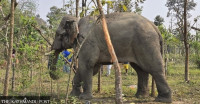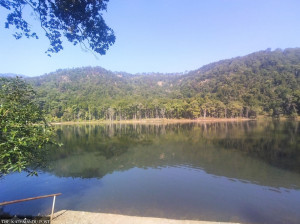Sudurpaschim Province
Shuklaphanta National Park running out of space to accommodate growing blackbuck population
The national park has built a special sanctuary on 59.8 hectares of the park land in Hirapur Phanta, which is home to 203 blackbucks.
Bhawani Bhatta
The Shuklaphanta National Park has made great strides in increasing the number of blackbucks (Antilope cervicarpa) in the Hirapur area over the last few years. However, the national park is currently facing space constraints to accommodate the growing blackbuck population.
The national park has built a special sanctuary in a predator-proof enclosed area on 59.8 hectares of land in Hirapur Phanta.
Between 2012 and 2015, a total of 42 blackbucks were translocated to the national park—22 from Nepalgunj Mini Zoo, six from the Central Zoo in Lalitpur, and 14 from Blackbuck Conservation Area in Bardiya.
The total number of blackbucks in the national park currently stands at 203, which includes 67 male, 87 female and 49 calves, according to the national park.
According to Lakshmiraj Joshi, head of the Shuklaphanta Conservation Programme of the National Trust for Nature Conservation, the protected enclosure in Hirapur Phanta can provide a comfortable sanctuary for the existing blackbucks but will not be able to accommodate more.
“The grazing area is just about enough for the current population of blackbucks. We have managed additional feed for them but it is now time to think about expanding the area of the enclosure to accommodate the growing population,” said Joshi.
Hirapur Phanta is located near Arjuni Postal Office on the East-West Highway.
Kishore Kumar Mehta, chief conservation officer of the national park, said that in the initial years of blackbucks translocation, there wasn’t much improvement in their numbers mostly due to infighting among the males leading to critical injuries and death of the animals.
“We also lost some blackbucks to ringworm infection,” said Mehta. “But over the past few years, things have improved and we have seen a massive increase in their population. It is overall good news for the conservation of the critically-endangered animals. But now we must make plans to provide them with bigger space.”
According to Mehta, management plans for the blackbucks are being made in coordination with the Department of National Park and Wildlife Conservation (DNPWC).
“We also need to focus on expanding our medical support services for the blackbucks to control disease outbreaks,” said Mehta. “We need to allocate a separate area for breeding and increase surveillance and expand their enclosure to give them access to the wider grasslands.”
The blackbucks must either be released into the wild or translocated elsewhere. Releasing the blackbuck population inside the national park, which has an area of only 305 sq km and is surrounded by farmlands and settlements, may not be practical.
Mehta says discussions are to translocate the blackbucks to conservation areas in other parts of the country. “First priority is to expand their territory within the Shuklaphanta National Park, but if that doesn’t work then we must think about translocating some of them to other national parks and protected areas,” he said.
Blackbucks were once found in several parts of the Tarai, but mainly in Kanchanpur, Bardiya and in the floodplains of the Rapti River in Banke. Owing to gradual deforestation and the shrinking of grasslands, the blackbuck population dwindled drastically during the late 1950s and early 1960s due to habitat loss and poaching, according to the records of the Department of National Park and Wildlife Conservation.
By the early 1970s, the blackbuck was considered extinct in Nepal before nine of the species were spotted in 1975 in Khairapur of Bardiya.
The Nepal government started conservation and preservation of the animal’s natural population by declaring an area of 172 hectares in Khairapur, Bardiya as the Blackbuck Conservation Area in 2009.




 15.12°C Kathmandu
15.12°C Kathmandu












